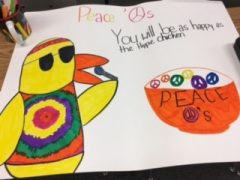Teacher(s) Name: Mrs. Faini
School: Echo Lake ES
Grade Level(s): Grade 4
Content Area(s): Children’s Engineering, Gifted, Language Arts
Lesson Summary
As a post-SOL project, my two sections of Literacy class were tasked with creating a product, and then designing the advertising campaign that would accompany it.
As most students are familiar with breakfast cereal, after a study of current cereal brands, groups developed a new breakfast cereal that would appeal to as many buyers as possible. These cereal brands had to follow a Z pattern of reader scanning, including the name of the product, a headline, an illustration, and sales talk.
As a class, we voted on the cereals we would advertise. We studied types of advertising persuasion by analyzing print, audio and visual ads. We also learned about common components of these advertisements, including the use and meaning of various colors, repetition, print variation, music and sound effects, and near falsehoods. Each creative team divided their tasks into three groups: print, audio and visual ads.
We viewed and listened to advertisements to have a model to base our work on, while avoiding plagiarism! We used the Audacity program to record our audio ads, and we researched and found copyright free music to use in the background. Our videos were shot on an I-pad. Print advertisements were created on Comic Life, Word, or hand drawn. We also utilized Google Drive to share our efforts with each other.
We culminated our efforts by having both my sections of my Literacy students in the room at once and presented our videos, print ads and audio ads.
TIPC Ratings
Research & Information Fluency
Rating:Approaching – Explanation: Teacher: Approaching (3-4) Students had not explored media messages prior to this unit, leading to some direct instruction on vocabulary and basic concepts. Modeled strategies for analyzing media and prompted toward a fuller understanding.
Student: Developing (2): Students analyzed based on models and used notes and prior examples to do their analysis.
Communication & Collaboration
Rating: Ideal – Explanation: Teacher: Ideal/Target.(7) Once students had the information needed to proceed, they were fully engaged in the tasks of creating three different types of media messages. Work was real world, and teacher used conferences and group meetings to move the activity forward.
Student: Ideal (6). Students selected methods and tools and reflected in groups on their communication. However, we did not communicate with anyone other than our classmates, or utilize experts.
Critical Thinking & Problem Solving
Rating: Ideal – Explanation: Teacher: Ideal (6) Tasks were assessed using a rubric. Students who had trouble meeting goals had the opportunities to asses, recreate, and resubmit.
Students: Ideal (6). Students could select any digital tools that were available, and while most choose conventionally, some students used critical thinking and explored digital tools on their own.
Creativity & Innovation
Rating: Approaching – Explanation: Teacher: Approaching (5) Created opportunities for creative and original work that was done collaboratively.
Student: Approaching (5): Created meaningful original work.



